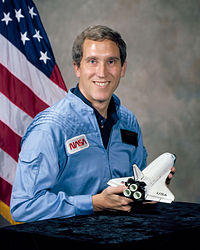Michael John Smith
| Mike Smith | |
|---|---|

|
|
| Country: |
|
| Organization: |
|
| selected on | May 19, 1980 (9th NASA Group) |
| Calls: | 1 flight that did not reach space |
| Start of the first space flight: |
January 28, 1986 |
| Landing of the last space flight: |
(killed at start) |
| retired on | January 1986 (accident) |
| Space flights | |
|
|
Michael John "Mike" Smith (born April 30, 1945 in Beaufort , North Carolina , USA ; † January 28, 1986 near Cape Canaveral , Florida ) was an American naval aviator and astronaut who served on the Challenger mission STS-51 -L belonged to. When the space shuttle crashed, all seven crew members were killed.
Military career
Smith graduated from Beaufort High School in 1963 and studied naval engineering at the United States Naval Academy in Maryland . After his bachelor's degree , which he received in 1967 (of the 893 graduates of the year, he was ranked 108), he went to the Naval Postgraduate School in Monterey, California and received a master's degree in aerospace engineering a year later .
Upon graduation, Smith was trained as a Navy pilot in Texas and then served as an instructor at Advanced Jet Training Command. From spring 1971 he served on the aircraft carrier " USS Kitty Hawk " as a pilot for the A-6E "Intruder" in the Vietnam War . After the war he was in Maryland at the United States Naval Test Pilot School (USNTPS) for test pilots trained. Following the exam, he worked from 1974 on developing a target recognition sensor for the A-6 Intruder. In 1976 he returned to the USNTPS as an instructor for a year and a half before patrolling the Mediterranean with a unit aboard the USS Saratoga . In favor of space travel, he finally left active service as a soldier in the United States Navy with the rank of captain .
NASA activity
Smith was selected for the NASA space program in May 1980 . He was one of eight pilots who had qualified for the space shuttle . Together with eleven mission specialists, they formed the ninth astronaut group of the US space agency. The training began in the fall of 1980 and ended a year later.
After Mike Smith received his first space flight mandate in the summer of 1984, which did not take place (he was supposed to be a pilot on STS-51-H , a repeat flight in November 1985 of Spacelab-1 experiments , but which was canceled), he was appointed in January 1985 to the pilot of STS-51-L : After the second communications satellite of the TDRS series was deployed ten hours after take-off, Halley's Comet , which was near the earth at the time, was to be observed. The SPARTAN satellite was on board for this purpose and was to be launched on the third day of the flight so that the comet could be observed undisturbed for 40 hours. When the shuttle took off on January 28, 1986, it broke apart just 73 seconds later. All seven astronauts were killed.
After that, Smith was nominated for another flight ( STS-61-I ) in September 1985 , which was supposed to take place in the fall of 1986, but was not operated as STS-32 until 1990 due to the 51-L disaster .
Mike Smith was buried in Arlington National Cemetery. He left behind his wife Jane and three children. In honor of the astronaut, an airfield at his place of birth bears his name (Michael J. Smith Field Airport). The asteroid (3351) Smith was named after him in March 1986.
See also
Web links
- Short biography of Michael John Smith at spacefacts.de
- NASA biography of Michael John Smith (PDF)
- Biography of Michael John Smith in the Encyclopedia Astronautica (English)
Individual evidence
| personal data | |
|---|---|
| SURNAME | Smith, Michael John |
| ALTERNATIVE NAMES | Smith, Mike |
| SHORT DESCRIPTION | American astronaut |
| DATE OF BIRTH | April 30, 1945 |
| PLACE OF BIRTH | Beaufort , North Carolina, USA |
| DATE OF DEATH | January 28, 1986 |
| Place of death | Cape Canaveral |
